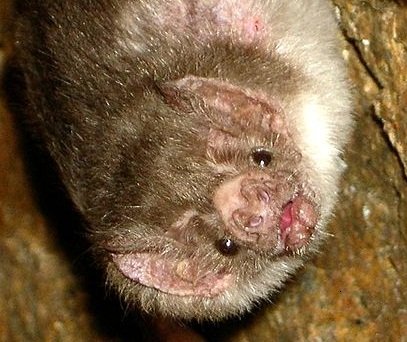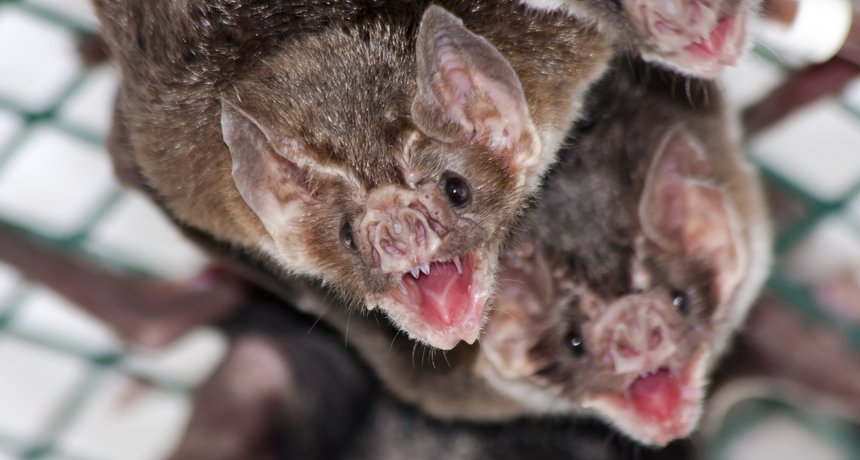Common Vampire Bat: Desmodus Rotundus

The Desmodus Rotundus is a vampire bat that is the most abundant and most widespread species of vampire bats. Desmodus mainly feeds on mammals, especially livestock. They occur southward through Central America and much of South America from northern Mexico to Uruguay, Northern Argentina, central Chile, and Trinidad Island in the West Indies. 1Go To Source depts.ttu.edu -“VAMPIRE BATS – The Good, the Bad, and the Amazing”
Learn More: Biggest Bat
Description Of The Common Vampire Bat
On the ventral side, Desmodus rotundus has grayish-brown fur that is lighter. The muzzle is compact and swollen in appearance, and the ears are pointy. The average wingspan is 350-400mm, and the length of the head and body is generally 70-90mm. There is no tail on the common vampire bat, and the membrane between the hind legs, called the uropatagium, is reduced. Usually, females are larger than males.
Due to its specialized feeding behavior, the common vampire bat is highly adapted. The brain is large, and the rostrum is reduced to accommodate large incisors and razor-sharp canines. As the bat feeds, there are two lateral grooves in the tongue that expand and contract. There is an acute sense of smell and large eyes in Desmodus rotundus. 2Go To Source animaldiversity.org -“Desmodus rotundus vampire bat”
Common Vampire Bat Habitat

This species is restricted to hot climates. Common vampire bats can be found in the tropics and subtropics in both arid and humid parts. Typically roosts take place at up to 7,800 ft above sea level. In moderately lighted caves with deep fissures and tree hollows, Vampire Bats roost. Common vampire bats can utilize old wells, mine shafts, and abandoned buildings as roosting locations. 3Go To Source seaworld.org -“Common Vampire Bat”
Range Of Common Vampire Bats
Places that common vampire bats are found include:
- Chile
- Argentina
- Uruguay
- South America
- Central America
- Northern Mexico
Common Vampire Bat Diet
These bats feed on animal blood exclusively, which is called hematophagy. The only mammals that only feed on blood are vampire bats. Each species has prey preferences that are slightly different. The common species only feeds on mammals, and the other two will feed on birds as well. Thermoreceptors are used on their noses to locate the blood vessels closest to the skin surface. As stated above, the bats specialized teeth create a small incision, and anticoagulant saliva keeps the blood flowing. 4Go To Source animals.net -“Vampire Bat”
Only under the darkest of conditions do vampires prefer to hunt. As a rule, when the moon is visible, they will not fly, presumably decreasing detection by potential prey. Vampires have good memories, and they can remember the herds’ approximate location they feed on regularly.
Many roosts are also frequent, enabling them to follow a specific herd over a large geographic range. Researchers have found that some prey animals are visited repeatedly by vampires and virtually ignore others. It is unknown why this occurs, although an animal’s relative position in a herd, such as feeding on the animals on the herd’s outskirts. 5Go To Source batcon.org -“VAMPIRES: THE REAL STORY”
Behavior Of Common Vampire Bats

The vampire bat has become infamous for its feeding practices. The bat uses its sharp incisors to create the initial incision, rather than sucking blood and then laps up the blood. The incisors are so sharp that the bite will not be felt by the animal being fed. This bat’s saliva is equipped with a substance that can turn clotted blood into liquid again, allowing it to feed longer, but it rarely kills its prey and is unlikely to feed a human. Instead, these bats tend to target Central and South America’s abundant herds of livestock and cause farmers problems by spreading disease.
They’ve got a complex social life as well. For the first two months of life, females usually give birth to a single offspring each year, feed it milk, introduce regurgitated blood alongside the milk when the infant is one month old, and take it hunting when it reaches four months of age.
Adult bats sometimes feed on regurgitated blood, as do infants. If their hunting is unsuccessful, vampire bats can starve to death in just three days, and adult bats regurgitate for each other. With the same bats feeding each other on many different occasions, unrelated individuals create what seem to be long-term relationships. 6Go To Source worldlandtrust.org -“common vampire bat”
Common Vampire Bat Mating and reproduction
Within the same habitat, male and female vampire bats tend to roost separately. In one corner, female bats will huddle together, and males will do the same on the roost’s opposite side. A few males will roost with the females to provide protection. The males’ role is to protect the females, the young, and the sub-adults within the group of females. Although known to roost separately, the vampire bats will all huddle together when temperatures get below 11 ° C to maintain internal body temperatures. It’s common for females to become pregnant during this time due to the winter months’ huddling.
Vampire bats are mammals, so their reproduction is comparable to human reproduction. Within their bodies, the Desmodus rotundus carry their young. The vampire bat carries its fetus for an extended period, ranging from three to seven and a half months. With most births occurring in the spring and summer months, females usually give birth about once a year. When a female vampire bat goes into labor, she’ll fly to the top of her home and hang upside down. What people would consider right side up is upside down to a bat. She hangs this way so that with her wings and curled up tail, she can create a pouch. When the babies are delivered, female bats construct this pouch to catch the pup (baby bat). The offspring remains very close to its mother for quite a while once the pup is delivered. 7Go To Source bioweb.uwlax.edu -“Desmodus Rotundus”
References:
- “VAMPIRE BATS – The Good, the Bad, and the Amazing.” Texas Tech University, TTU, www.depts.ttu.edu/nsrl/get-involved/downloads/vampire-bat-exhibit.pdf. Accessed May 2014.
- Mulheisen, M. and R. Anderson 2001. “Desmodus rotundus” (On-line), Animal Diversity Web. Accessed January 18, 2021 at https://animaldiversity.org/accounts/Desmodus_rotundus/
- “Common Vampire Bat Facts and Information | SeaWorld Parks & Entertainment.” Sea World, SeaWorld Parks & Entertainment, seaworld.org/animals/facts/mammals/common-vampire-bat. Accessed 18 Jan. 2021.
- Oldham, Cydni. “Vampire Bat.” Animals Network, 2 Oct. 2018, animals.net/vampire-bat.
- Bat Conservation International. “VAMPIRES: THE REAL STORY.” Bat Conservation International, Bat Conservation International, 15 Apr. 2020, www.batcon.org/article/vampires-the-real-story.
- Farrows. “Common Vampire Bat: Species in World Land Trust Reserves.” World Land Trust, 19 June 2019, www.worldlandtrust.org/species/mammals/common-vampire-bat.
- “UWL Website.” University Of Wisconsin Lacrosse, UWLAX, bioweb.uwlax.edu/bio203/f2012/ward_alys/reproduction.htm. Accessed 18 Jan. 2021.
